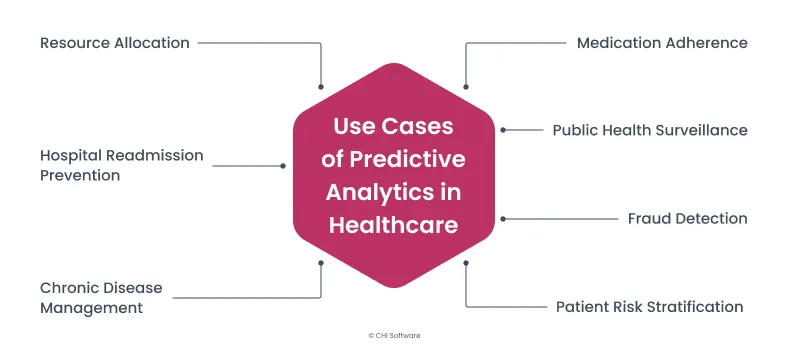Just let this statistic sit in your mind for a minute: the healthcare industry generates around 30% of the world’s data. But for now, most healthcare organizations have barely scratched the surface of putting their data to use. How do you begin harnessing the full potential of your datasets? The most efficient option is to implement predictive analytics. And here’s why.
Predictive analytics, an AI subset, can take any volume of data and potentially find patterns that humans would miss or ignore. Have you ever tried conducting an analysis of every document your company has ever produced and trying to come up with predictions based on it? Such a task is hardly possible for humans, but relatively simple for AI. Predictive analytics could have a lot to offer to your business. Would you like to know more?
In this article, CHI Software explains predictive analytics in detail:
- how it impacts the industry,
- what applications you can consider now,
- how to find an AI integration team.
Let’s start with basic explanations and promising statistics.
The Power of Predictive Analytics in Healthcare
Predictive analytics in healthcare refers to using data and noticing trends, and making predictions with the help of AI algorithms.
Let’s consider an example. Hospitals can analyze their statistical data, seasonal factors, or medical resource utilization to improve current workflows and offer personalized care for every patient. In other words, healthcare organizations can use their data to better prepare for the future.
Big Data, Big Impact: How Analytics Are Transforming Healthcare
Read more
Now, how does it work? The process is divided into two steps: data collection and analysis:
- Hospitals gather vast information from electronic health records, wearable devices, financial documentation, and more. This data is then processed and analyzed to identify patterns, trends, and correlations.
- Next, sophisticated algorithms come into play, using the collected data to build predictive models that forecast outcomes such as disease diagnosis, patient readmissions, medication adherence, and even operational efficiency within healthcare facilities.

Now, we’d like to show you some statistical trends demonstrating the impact of innovations in predictive analytics. According to Grand View Research, the global market of healthcare predictive analytics reached USD 11.7 billion in 2022 and is likely to grow by 24.4% year over year.
The two main reasons behind such impressive growth are a chance to improve patient outcomes on the one hand and reduce healthcare costs on the other.
As a result, predictive analytics appeared to be most helpful during the harshest pandemic period, which led to a 63.9% market leap in the 2020s compared to 27.4% in 2019.
How and where do healthcare companies apply predictive analytics? Fortune Business Insights sees two main scenarios from data analytics:
- Trends coming from electronic health record (EHR) systems;
- Monitoring patient condition based on the information from the Internet of Medical Things (IoMT) devices.
Predictive analytics is a real chance to change things for the better in healthcare, helping the industry become resilient to the unknown during turbulent times. But what else is there?
How Predictive Modeling Transforms Patient Care
In the ever-evolving world of healthcare, predictive analytics can become one of the most helpful tools in your company’s arsenal. In this section, we’ll talk about all the advantages offered by innovation.

Early disease detection: Analyzing patient data and spotting subtle warning signs help healthcare providers intervene proactively and prevent serious health issues.
Personalization: No two patients are alike, and predictive analytics recognizes that. Using individual patient data (medical history, genetics, and lifestyle factors), healthcare professionals can tailor treatment plans to meet each patient’s unique needs. This personalized approach enhances treatment outcomes and improves patient satisfaction.
Enhanced patient outcomes: Ultimately, the goal of predictive analytics in healthcare is to improve patient outcomes. By predicting health trends, identifying at-risk populations, and intervening early, healthcare providers can help patients lead healthier lives, manage chronic conditions more effectively, and reduce the burden of preventable diseases.
Efficient resource management: Predictive analytics empowers healthcare organizations to make data-driven decisions regarding resource allocation. From staffing to inventory management, predictive models help optimize resources, reduce waste, and ensure that healthcare facilities operate efficiently.
Cost savings: Predictive analytics isn’t just about improving patient care – it’s also about saving costs. AI solutions can optimize resource allocation, streamline operations, and prevent unnecessary hospital readmissions. It opens a new page in healthcare cost optimization, potentially making high-quality treatment affordable for more people.
Improved population health: Predictive analytics enables healthcare providers to identify trends, patterns, and risk factors within communities by analyzing population-level data. This insight allows for targeted interventions, public health initiatives, and preventive measures to promote overall population health and well-being.
A new era of healthcare is coming! But the question is, will you be a part of it? Let’s find out how you can join.
Key Applications of Healthcare Data Analysis
It’s time to get specific. This section explains the most popular predictive analytics use cases that are changing healthcare at this very moment. Innovations are here, and this is how they look in real life.

Hospital Readmission Prevention
Hospital readmissions can significantly burden patients and healthcare systems. Predictive analytics solutions can forecast the likelihood of a patient’s readmission based on information about post-discharge care, socioeconomic status, and previous hospitalizations.
Resource Allocation
Using predictive models to anticipate demand fluctuations, hospitals can adjust staffing levels, bed capacities, and inventory supplies to provide smooth operations and high-quality patient care. All of it is possible with just one AI tool.
From Data Centers to Patient Care: The Cloud’s Impact on Healthcare Efficiency
Read more
Patient Risk Stratification
Predictive analytics help healthcare professionals stratify patients based on their risk profiles, including by age, medical history, and comorbidities. This segmentation allows for personalized care plans, well-targeted treatments, and closer monitoring of high-risk individuals, ultimately improving patient outcomes.
Medication Adherence
Ensuring that patients adhere to their medication regimens is crucial for effective treatment plans. Based on historical data and behavioral patterns, algorithms can predict which patients are likely to be non-compliant.
Healthcare providers can then implement specific measures, such as reminders, education programs, or personalized support to ensure that patients stick to their medication and treatment plans, leading to better outcomes.
mHealth App Development: The Complete Guide
Read more
Chronic Disease Management
Predictive analytics can assist in predicting disease progression and complications in patients with chronic illnesses. With predictive models, healthcare providers can tailor treatment plans, schedule follow-up appointments, and help patients better manage their conditions to improve their quality of life.
Public Health Surveillance
Predictive analytics is instrumental in public health surveillance and outbreak detection. Based on population data, environmental factors, and disease trends, predictive models can forecast disease outbreaks, identify at-risk populations, and guide public health initiatives.
Fraud Detection
Healthcare fraud is a significant challenge that impacts the integrity of healthcare systems and can significantly increase costs. Predictive analytics can help identify suspicious billing patterns, unusual claims, and potential fraudulent activities. Predictive models monitor billing data and provider behavior to flag anomalies and alert authorities, safeguarding healthcare funds and upholding the system’s integrity.
Implementing Predictive Analytics Tools in Your Organization: Tips from Our Team
To leverage the power of predictive analytics in healthcare, you need to invest in the right skills and technology. Adopting predictive analytics solutions may seem daunting for an organization, but starting with a few key steps can help ease the transition.

1. Find the Right Partners
It’s easier said than done! But that’s where everything starts. Unless you have an internal team of data scientists and engineers, partnering with a predictive analytics engineering provider is vitally important.
Look for a vendor that specializes in healthcare and has a track record of improving outcomes and reducing costs. They should offer development services that integrate easily into your existing systems and provide monitoring if needed. (Read more about choosing your vendor in the next article section or contact our AI engineers right away.)
2. Start with a Minimum Viable Product (MVP)
Rather than an organization-wide rollout, try implementing predictive analytics solutions in a limited pilot program. MVPs are all about this – they are smaller versions of something big. A step-by-step approach will help you demonstrate the value to key stakeholders before making a larger investment.
Here are two important things to keep in mind:
- Choose a high-impact area like reducing hospital readmissions or optimizing staff scheduling. What exactly do you want your solution to do? What are its goals? Discuss everything with engineers so they can come up with a basic set of features.
- Set concrete metrics to measure the success of the pilot. If goals are met, use the evidence to make the case for continuing the project and expanding the innovations to other departments.
Saving Lives with Data: Machine Learning in Healthcare
Read more
3. Focus on Adoption and Change Management
Even the most advanced predictive analytics solutions won’t achieve results if your staff does not adopt them. Focus on organizational change management to ensure new tools and processes are embraced.
Provide ongoing education about how the technology works and the benefits it brings:
- Be transparent about how job responsibilities and workflows may evolve;
- Offer incentives for teams and individuals who achieve the best outcomes;
- Designate super users who can motivate their peers.
4. Continually Optimize and Improve
Even with the right solutions in place, the work is not done yet. Monitor how the technology is used and make adjustments as needed to boost adoption and impact:
- Stay on top of innovations and consider upgrades to take advantage of the latest advancements in the AI field;
- Review metrics regularly and tweak algorithms or data inputs to improve accuracy;
- Meet with stakeholders and end users to gather feedback on what’s working and where there’s room for improvement.
By following these steps, you can implement predictive analytics in your organization in a strategic and thoughtful way. Start small, focus on managing the transition, and continue optimizing your solutions to achieve the best results.
Overcoming Barriers to Effective Data Forecasting
To successfully implement predictive analytics in healthcare, you’ll need to overcome some significant barriers. As the saying goes, “knowledge is power,” but in the data world, high-quality data is power.

Garbage in, garbage out. Without accurate, complete data, your predictions will be flawed and unreliable.
Many healthcare organizations struggle with data quality and governance issues. Patient data may be spread across multiple systems that don’t integrate well, and staff may enter data inconsistently or make frequent errors.
You’ll need to invest in consolidating systems, standardizing data entry, and double-checking data for accuracy. It can be tedious work – but it’s critical for ensuring your predictions are based on high-quality data.
Privacy and security concerns also pose barriers to effective data use. Healthcare data is highly sensitive, and regulations like HIPAA limit how data can be shared and used.
It helps to implement strict controls and oversight to keep data private and secure. You should also be transparent with patients about how their data may be used and give them options to opt out of data sharing whenever possible.
A lack of data science expertise is another common barrier. Data scientists who understand healthcare data and predictive modeling techniques are in high demand but short supply.
You may need to hire consultants and outside experts (like the ones from CHI Software) to help set up your predictive analytics programs. Otherwise, be prepared to pay high salaries to hire and retain top data science talent on your team.
Cultural barriers can also hamper effective data use. Many healthcare organizations have a reactive, experience-based culture rather than a data-driven one, so staff may resist using data and algorithms to guide decisions.
You’ll need to invest in educating staff about the benefits of predictive analytics and to create a culture where data-driven insights are valued and routinely used to improve care.
Choosing the Right Vendors and Technologies
As innovations may be stressful in some organizations, we decided to cover the first step from the previous section in more detail. What should you look for in your perfect AI team? We’ve prepared some hints for you below.

Look for Experience and Expertise
When selecting a predictive analytics vendor for your healthcare organization, experience and expertise should be at the top of your checklist:
- Look for vendors that have a proven track record of success in healthcare settings similar to yours;
- Ask about the types of algorithms and models they have developed for healthcare clients;
- See if they have experience with EHR data, patient outcomes, risk stratification, and more.
Vendors with healthcare-specific expertise will be better equipped to understand your goals and constraints, and they can recommend approaches tailored to healthcare.
Evaluate the Technology and Partners
Some vendors develop their own proprietary software and solutions for predictive analytics. Others may rely on open-source options or partner with third-party technology companies. Consider what will work best for your needs and technical capabilities.
Proprietary systems may be more customizable but often come with higher costs and less flexibility. Open-source or partnered options typically have lower upfront investments but may require more technical resources to implement and maintain.
IoT Healthcare Solutions: Innovating Care Delivery With Connected Devices and Data Analytics
Read more
Data Security and Governance
Predictive analytics in healthcare depends heavily on patient data, so data security and governance should be a high priority in your vendor evaluation.
Ask potential vendors about their data security policies, safeguards, and compliance with regulations like HIPAA. They should follow strict guidelines for de-identifying patient data and obtaining proper consent.
You’ll also want to understand how they manage data access and governance policies. Vendors with a strong track record of data responsibility and transparency will have established protocols that minimize patient privacy and security risks.
Ongoing Support and Optimization
The work doesn’t stop once a predictive model is developed and implemented. Your chosen vendor should provide ongoing support to help optimize the model over time. As new data is collected and healthcare practices evolve, the model will need re-training and updating to sustain or improve its accuracy and utility.
Look for vendors that offer continued model maintenance, re-training, and performance monitoring services. They should also be willing to work with your teams to determine how model outputs and insights can best be operationalized to improve care delivery, patient outcomes, and cost reductions. With regular optimization and collaboration, your investment in predictive analytics can have a long-term impact.
How to Create a Health Insurance Mobile Application
Read more
Conclusion
We’ve covered a lot of ground on how predictive analytics can transform healthcare, but the key takeaway is that artificial intelligence is ready to make a huge impact right now. Technology available today is already mature enough to implement pilot programs, see quick wins, and scale up over time.
Don’t wait around thinking this is years off – the future is already here for data-driven healthcare. Take the first step by auditing your needs, finding the right partners, and launching an MVP. Start small but think big.
With the power of AI, the sky’s the limit on how you can improve patient outcomes, lower costs, and usher in a new era of healthcare. The time is now to tap into the promise of predictive analytics, so don’t hesitate to fill in this contact form. You’ve got this!
FAQs
-
What is predictive analytics in healthcare, and how is it used?

Predictive analytics in healthcare uses data and algorithms to predict patient health outcomes and allocate hospital resources. It's like foreseeing possible events to take proactive measures for better care.
-
How does predictive analytics benefit healthcare organizations and patients?

Predictive analytics helps healthcare providers make informed decisions about staff workload and medical tools’ utilization, personalize treatment plans, improve patient outcomes, and reduce costs. Patients, in turn, receive better care tailored to their individual needs. It’s a win-win combination!
-
What are some real-world examples of predictive analytics applications in healthcare?

Real-world examples include predicting readmissions, identifying high-risk patients, forecasting disease outbreaks, and optimizing hospital resources for improved efficiency.
-
What data sources are utilized for predictive analytics in the healthcare industry?

Data sources include electronic health records (EHRs), administrative documents, medical imaging, wearable devices, patient surveys, and social determinants of health, such as demographics and lifestyle factors.
-
What are the challenges and considerations in implementing predictive analytics in healthcare settings?

Challenges include data privacy and security concerns, data quality issues, regulatory compliance, staff training, integrating predictive analytics into existing workflows, and ensuring the ethical use of predictive models.
About the author
Alex Shatalov
Data Scientist & ML Engineer
Alex is a Data Scientist & ML Engineer with an NLP specialization. He is passionate about AI-related technologies, fond of science, and participated in many international scientific conferences.








